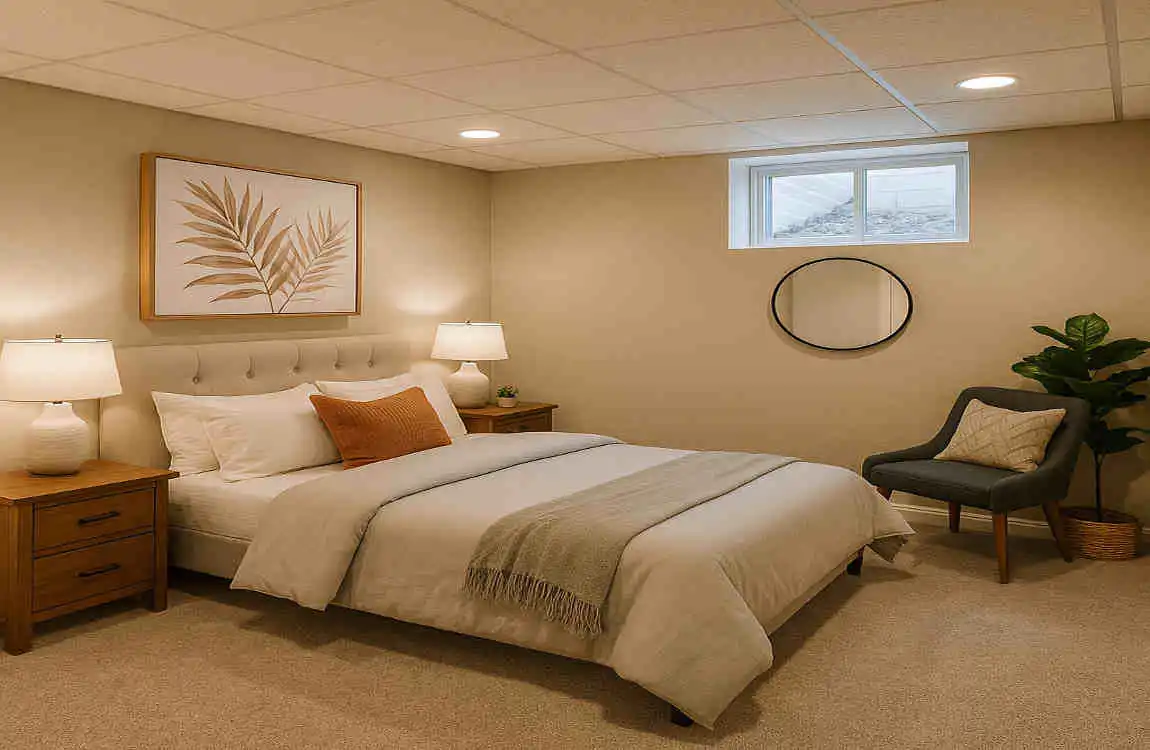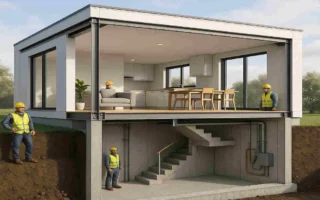Do you have a basement that’s just sitting there, collecting dust and cobwebs? Have you ever considered turning it into a cosy bedroom? Basement bedrooms are a fantastic way to maximise your home’s space and add value to your property. But what exactly makes a basement bedroom?
Understanding What Makes a Basement Bedroom Unique

What is a Basement Bedroom?
A basement bedroom is a room located below ground level that’s been converted into a sleeping area. These spaces can serve various purposes, from guest rooms and family rooms to rental units. But what sets them apart from upper-floor bedrooms?
Challenges Faced by Basement Bedrooms
Basement bedrooms often face unique challenges, such as limited natural light, poor ventilation, and moisture issues. These factors can make it tricky to create a comfortable and healthy living space.
How Basement Bedrooms Differ from Upper-Floor Bedrooms
Unlike upper-floor bedrooms, basement bedrooms are surrounded by earth on three sides, which can affect temperature, humidity, and overall ambience. It’s crucial to understand these differences when planning your basement bedroom design.
Meeting Building Codes and Safety Regulations
Before you start your basement bedroom project, ensure your design meets local building codes and safety regulations. This includes having proper egress windows, fire safety measures, and adequate ceiling height.
Essential Structural Features of a Basement Bedroom
Egress Windows: Legal Requirements and Benefits
Egress windows are a must-have for any basement bedroom. Not only do they provide a safe emergency exit, but they also let natural light into the space, making it feel brighter and more inviting.
Adequate Ceiling Height: Minimum Standards and Design Solutions
Most building codes require a minimum ceiling height of 7 feet in a basement bedroom. If your basement has low ceilings, don’t worry! There are plenty of design solutions, such as recessed lighting and low-profile furniture, that can help create a more spacious feel.
Proper Insulation and Waterproofing
To ensure comfort and durability, it’s crucial to properly insulate and waterproof your basement bedroom. This will help regulate temperature, reduce moisture, and prevent mould growth.
Soundproofing Considerations
If your basement bedroom is located near noisy areas, such as a laundry room or home theatre, consider incorporating soundproofing measures. This can include using sound-absorbing materials, such as acoustic panels or thick carpets, to create a peaceful sleeping environment.
Moisture Control and Ventilation: Creating a Healthy Basement Bedroom
Why Moisture Control is Crucial
Excess moisture can lead to a host of problems in a basement bedroom, including mould growth, musty odours, and structural damage. That’s why it’s essential to prioritise moisture control in your design.
Effective Waterproofing Methods and Materials
There are several effective waterproofing methods and materials you can use to keep your basement bedroom dry and comfortable. These include applying waterproof coatings, installing drainage systems, and using moisture-resistant materials for walls and floors.
Installing Ventilation Systems and Dehumidifiers
Proper ventilation is key to maintaining a healthy basement bedroom. Consider installing a ventilation system or using a dehumidifier to keep the air fresh and dry.
Avoiding Mould and Mildew Growth
Mould and mildew can quickly take over a damp basement bedroom. Keep an eye out for signs of growth, such as black spots on walls or a musty smell, and take preventive measures, such as using mould-resistant paint and regularly cleaning surfaces.
Lighting Solutions for Basement Bedrooms
Natural Light Enhancement
While basement bedrooms may not have as much access to natural light as upper-floor bedrooms, there are still ways to enhance the available light. Consider installing window wells, using glass blocks, or adding light tubes to bring more natural light into the space.
Layered Artificial Lighting
In addition to natural light, it’s essential to have a well-planned artificial lighting scheme in your basement bedroom. This should include ambient lighting for overall illumination, task lighting for specific activities, and accent lighting to highlight decorative elements.
Choosing the Right Light Fixtures and Bulbs
When selecting light fixtures and bulbs for your basement bedroom, consider the mood you want to create. Warm, soft lighting can help make the space feel cosy and inviting, while brighter, cooler lighting may be better suited for task areas.
Using Mirrors and Reflective Surfaces
Mirrors and reflective surfaces can help amplify the light in your basement bedroom, making it feel brighter and more spacious. Consider incorporating these elements into your design to maximise the impact of your lighting scheme.
Designing for Comfort and Style

Selecting Bedroom Furniture
When choosing furniture for your basement bedroom, consider the space’s size and layout. Opt for pieces that are appropriately scaled and can be arranged to create a comfortable and functional sleeping area.
Colour Schemes to Brighten and Open Up the Space
Light, neutral colours help make a basement bedroom feel brighter and more open. However, don’t be afraid to incorporate bold accents to add personality and style to the space.
Flooring Options
When selecting flooring for your basement bedroom, look for options that are warm, moisture-resistant, and comfortable underfoot. Popular choices include carpet, vinyl plank, and engineered hardwood.
Adding Textiles for Cosiness and Sound Absorption
Textiles like rugs, curtains, and bedding can add warmth and cosiness to your basement bedroom. They can also help absorb sound, making the space feel more peaceful and private.
Creating a Multifunctional Space
If you want your basement bedroom to serve multiple purposes, consider using innovative furniture arrangements to create distinct zones for sleeping, working, and relaxing.
HVAC and Heating Solutions for Basement Bedrooms
Maintaining Comfortable Temperatures
To keep your basement bedroom comfortable year-round, you need an effective HVAC system. This may include a dedicated heating and cooling unit or a system that integrates with your home’s existing setup.
Types of Heating Systems
Several types of heating systems can work well in a basement bedroom, including radiant heat, electric heaters, and ductless mini-splits. Consider your specific needs and budget when selecting the best option for your space.
Integrating Air Conditioning or Cooling Options
If your basement bedroom gets too warm in the summer months, consider adding an air conditioning or cooling system. This can help keep the space comfortable and enjoyable even on the hottest days.
Importance of Proper Ventilation
Proper ventilation is crucial for maintaining good air quality in your basement bedroom. Make sure your HVAC system includes adequate ventilation to keep the air fresh and healthy.
Safety and Privacy Considerations
Fire Safety Measures
To ensure the safety of your basement bedroom occupants, it’s essential to have proper fire safety measures in place. This includes installing smoke detectors, carbon monoxide alarms, and providing a clear path to a fire escape.
Privacy Considerations
If your basement bedroom is near other living areas, consider installing soundproof doors and window treatments to enhance privacy. Use room dividers or curtains to separate the sleeping area from different parts of the basement.
Security Measures
To keep your basement bedroom secure, consider adding locks to windows and entry points. You may also want to install a security system or use smart home technology to monitor the space remotely.
Child-Safe Designs
If your basement bedroom will be used by children, make sure to incorporate child-safe design elements. This can include using rounded furniture corners, securing heavy items to the wall, and keeping hazardous materials out of reach.
Decorating Tips to Enhance Basement Bedroom Appeal
Using Artwork and Wall Decor
Artwork and wall decor can add personality and life to your basement bedroom. Choose pieces that reflect your style and create a cohesive look throughout the space.
Incorporating Storage Solutions
To keep your basement bedroom organised and clutter-free, consider adding storage solutions such as built-in shelving, under-bed drawers, and multifunctional furniture.
Creating Focal Points
Focal points like feature walls or statement furniture can draw the eye and add visual interest to your basement bedroom. Use these elements to anchor the space and create a cohesive design.
Making the Space Feel Less Like a Basement
To make your basement bedroom feel less like a basement and more like a cosy retreat, focus on creating a warm, inviting atmosphere. Use soft lighting, plush textiles, and comfortable furniture to create a space that feels welcoming and relaxing.
Practical Ideas to Maximise Storage and Functionality
Built-in Storage Units and Shelving
Built-in storage units and shelving can help you make the most of your basement bedroom’s space. Consider adding custom cabinets, bookcases, or closets to keep your belongings organised and accessible.
Under-Bed Storage Solutions
Under-bed storage is a great way to maximise space in a basement bedroom. Look for beds with built-in drawers, or use storage containers that slide under the bed frame.
Closet Design Tips
When designing a closet for your basement bedroom, consider the space’s specific needs. Consider including built-in shelving, hanging rods, and drawers to create a functional and organised storage area.
Utilising Vertical Space
Don’t forget to utilise the vertical space in your basement bedroom! Consider adding tall bookcases, hanging shelves, or using wall-mounted storage solutions to make the most of every inch.
Real-Life Examples and Inspiration
To help spark your creativity, let’s take a look at a few real-life basement bedroom design case studies and before-and-after transformations. These examples showcase innovative solutions to common basement bedroom challenges and can inspire your own project.
From Damp and Dark to Bright and Cosy
In this case study, a homeowner transformed a damp, dark basement into a bright, cosy bedroom. By adding an egress window, installing a dehumidifier, and using light, neutral colours, they created a space that feels warm and inviting.
Maximising Space in a Small Basement
In this example, a homeowner with a small basement created a functional and stylish bedroom by using innovative furniture arrangements and built-in storage solutions. By thinking vertically and making the most of every inch, they created a comfortable sleeping area that feels spacious and organised.
Creating a Multifunctional Space
In this case study, a homeowner turned their basement into a multifunctional space that serves as both a bedroom and a home office. By using room dividers and innovative furniture arrangements, they created distinct sleeping and working zones while maintaining a cohesive design.
For more inspiration and resources, consider reaching out to local professionals who specialise in basement remodelling. They can provide personalised advice and help you bring your vision for a basement bedroom to life.




